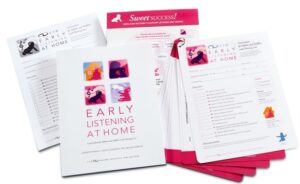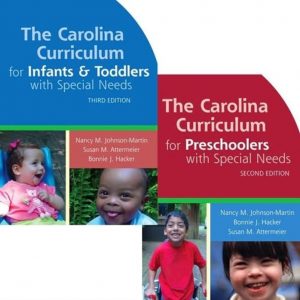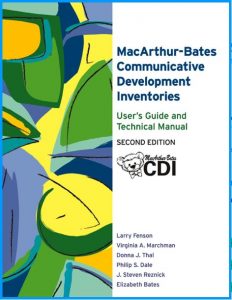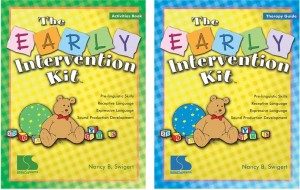Related Products
For Professionals
- Amplification
- Assessment of Student Skills, Challenges, Needs
- Early Childhood: Infants, Toddlers, Preschool
- Hearing Loss – Identification, Impact and Next Steps
- IDEA Law Summary Information
- Language and Speech Development Issues
- Legal Issues in Serving Children with Hearing Loss
- Listening (Auditory Skills) Development
- Planning to Meet Student Needs
- Self-Advocacy Skills for Students with Hearing Loss
- Self-Concept: How the Child with Hearing Loss Sees Himself
- Social Skills
- Speech Perception & Learning
Related Teacher Tools Takeout Items
7 Ways to Gather Great Information for Early Intervention to Preschool

Communication skills are at the heart of our concerns about the development of young children who are hard of hearing or deaf.
We need easily administered, functional, and fun ways to assess children’s development and to plan needed intervention.
Check out 5 ways we recommend gathering information on the communication of active children in early intervention to preschool!
- Do you work on communication needs with families of infants and toddlers with hearing loss?
- Are you part of an evaluation team assessing children with hearing loss exiting early intervention services?
- Do you sometimes have preschoolers on your caseload and need a place to start?
- Would you like functional assessments for young children that have been used with children who are deaf or hard of hearing?
Read on for 5 Ways to Gather Functional Information and Plan Intervention
 This is a curriculum for early intervention providers working with parents of children from birth to age 3 who are deaf and hard of hearing and beginning to learn listening and spoken language. It outlines skills and strategies to support parents and caregivers, including techniques for effective coaching, planning, and reflecting. There are 47 one-page activities for families to practice early listening skills and a simple form to track and follow up on progress. Transition to preschool with this information solves the question about the need for auditory skill development and appropriate goals. It also offers practical, shareable resources in English and Spanish and a tool for EI providers to help parents help their child become comfortable with hearing device use during all waking hours.
This is a curriculum for early intervention providers working with parents of children from birth to age 3 who are deaf and hard of hearing and beginning to learn listening and spoken language. It outlines skills and strategies to support parents and caregivers, including techniques for effective coaching, planning, and reflecting. There are 47 one-page activities for families to practice early listening skills and a simple form to track and follow up on progress. Transition to preschool with this information solves the question about the need for auditory skill development and appropriate goals. It also offers practical, shareable resources in English and Spanish and a tool for EI providers to help parents help their child become comfortable with hearing device use during all waking hours.
 The Carolina Curriculum is a long-time staple in providing assessment and intervention to infants, toddlers, and preschoolers with special needs. The curriculum comes with two parts, one for infants/toddlers (0-36 months) and one for preschoolers (24-60 months). Each item on the assessment tool is linked directly to a curriculum item that describes procedures for teaching the assessed skill. Assessment is linked to intervention through hierarchies of developmental tasks that are both relevant to typical routines and pertinent to long-term adaptation—thus integrating the intervention in a meaningful way into the child’s life. The Carolina Curriculum provides a comprehensive picture of the child’s development and helps teachers to clearly track child progress. There are domains of focus in the curriculum: personal/social, cognition, communication, fine and gross motor skills. Where the DRIP-EY and Early Listening at Home curriculums focus on the communication needs of young children with hearing loss, the Carolina Curriculum provides a broader context of overall development, which is key for planning appropriate placements.
The Carolina Curriculum is a long-time staple in providing assessment and intervention to infants, toddlers, and preschoolers with special needs. The curriculum comes with two parts, one for infants/toddlers (0-36 months) and one for preschoolers (24-60 months). Each item on the assessment tool is linked directly to a curriculum item that describes procedures for teaching the assessed skill. Assessment is linked to intervention through hierarchies of developmental tasks that are both relevant to typical routines and pertinent to long-term adaptation—thus integrating the intervention in a meaningful way into the child’s life. The Carolina Curriculum provides a comprehensive picture of the child’s development and helps teachers to clearly track child progress. There are domains of focus in the curriculum: personal/social, cognition, communication, fine and gross motor skills. Where the DRIP-EY and Early Listening at Home curriculums focus on the communication needs of young children with hearing loss, the Carolina Curriculum provides a broader context of overall development, which is key for planning appropriate placements.
 Larry Fenson, author of the MCDI, has very generously allowed use of communication development inventories that have been customized for children with spoken, signed, or cued expressive language – at NO COST. These simple inventories are provided to families to indicate the growth in expressive language over time, from 8 months to 36 months. Each of the inventories has been customized so families can indicate expressive language that is spoken, signed or cued, so that a complete picture of growth across modalities can be captured and compared to typically developing peers. The MCDI is an integral part of many early intervention programs. Download these customized inventories and the norm graphs from Teacher Tools Takeout. Part of the Teacher Tools Library!
Larry Fenson, author of the MCDI, has very generously allowed use of communication development inventories that have been customized for children with spoken, signed, or cued expressive language – at NO COST. These simple inventories are provided to families to indicate the growth in expressive language over time, from 8 months to 36 months. Each of the inventories has been customized so families can indicate expressive language that is spoken, signed or cued, so that a complete picture of growth across modalities can be captured and compared to typically developing peers. The MCDI is an integral part of many early intervention programs. Download these customized inventories and the norm graphs from Teacher Tools Takeout. Part of the Teacher Tools Library!
If a family wants their child’s language to progress at appropriate rate of development, there are some basic things they need to be aware of and include in their daily lives to facilitate communication. This free checklist is designed to allow the interventionist to discuss the child’s progress in language within the context of their consistency in providing communication access. Can be combined with the Formula for Success Contract, which helps clarify the responsibility of the family, and the early interventionists, in facilitating child communication development.
 The Early Intervention Kit is a great supplement to the hearing-loss-specific materials you already may be using (i.e., DRIP-EY, Early Listening at Home). Whether you are new to early intervention or a seasoned veteran, this Kit has ‘grab-and-go’ information that you will find yourself using with families again and again. Effectively address assessment, intervention, and documentation for pre-linguistic skills, speech and language development, and sound production. Filled with intervention techniques and skill hierarchies, the Kit will be a good resource for planning your intervention services and is complete enough to be a useful text for university programs. The Therapy Guide has information on assessment, goals, treatment, and documentation. The Activities Book is a gold mine of intervention objectives, goals, and specific suggested activities, for Pre-Linguistic Skills, Expressive Language Skills, Receptive Language Skills and Sound Production Development. Ages: Birth-3 Grades: Birth-PreK.
The Early Intervention Kit is a great supplement to the hearing-loss-specific materials you already may be using (i.e., DRIP-EY, Early Listening at Home). Whether you are new to early intervention or a seasoned veteran, this Kit has ‘grab-and-go’ information that you will find yourself using with families again and again. Effectively address assessment, intervention, and documentation for pre-linguistic skills, speech and language development, and sound production. Filled with intervention techniques and skill hierarchies, the Kit will be a good resource for planning your intervention services and is complete enough to be a useful text for university programs. The Therapy Guide has information on assessment, goals, treatment, and documentation. The Activities Book is a gold mine of intervention objectives, goals, and specific suggested activities, for Pre-Linguistic Skills, Expressive Language Skills, Receptive Language Skills and Sound Production Development. Ages: Birth-3 Grades: Birth-PreK.
Children who are deaf or hard of hearing are not ‘just kids with language delay who use hearing devices or sign’. They require the involvement of interventionists with a deep knowledge of how hearing loss impacts communication and other areas of development. In turn, these professionals need to have the tools they need to appropriately assess, plan intervention, and work with the families of these children. These 7 items all contribute to appropriate services for young children who are deaf or hard of hearing, birth to 3, and to gather information for preschool transition and beyond.
